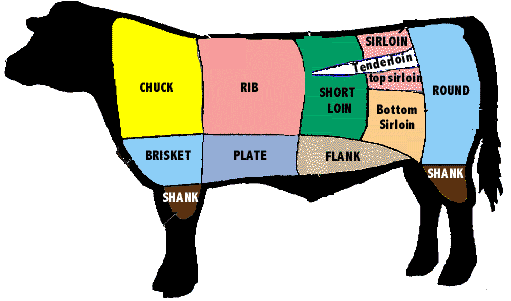| Home |
|
|
|
Know the cuts!

Thanks ED Informatics for the picture! (Go to it on their website here.)
Brisket - Bottom Sirloin - Chuck - Flank - Hamburger - Rib - Round
Soups/Salads - Shank - Short Loin - Sirloin - Top Sirloin - Tenderloin
According to the Beef Factsheet on the USDA Website:
Nutrition Labeling
Nutrition claims such as "lean" and "extra lean" are sometimes seen on beef
products. Here are their definitions:
"Lean" - 100 grams of beef with less than 10 grams of fat, 4.5 grams or less of
saturated fat, and less than 95 milligrams of cholesterol.
"Extra Lean" - 100 grams of beef with less than 5 grams of fat, less than 2
grams of saturated fat, and less than 95 milligrams of cholesterol.
Why is Beef Called
a "Red" Meat?
Oxygen is delivered to muscles by the red cells in the blood. One of the
proteins in meat, myoglobin, holds the oxygen in the muscle. The amount of
myoglobin in animal muscles determines the color of meat. Beef is called a "red"
meat because it contains more myoglobin than chicken or fish. Other "red" meats
are veal, lamb, and pork.
How to Handle Beef Safely
Raw Beef: Select
beef just before checking out at the register. Put packages of raw beef in
disposable plastic bags, if available, to contain any leakage which could
cross-contaminate cooked foods or produce. Beef, a perishable product, is kept
cold during store distribution to retard the growth of bacteria.
Take beef home immediately and refrigerate it at 40 °F; use within 3 to 5 days
(1 or 2 days for ground beef and variety meats such as liver, kidneys, tripe,
sweetbreads, or tongue) or freeze (0 °F). If kept frozen continuously, it will
be safe indefinitely.
It is safe to freeze beef in its original packaging or repackage it. However,
for long-term freezing, overwrap the porous store plastic with aluminum foil,
freezer paper, or freezer-weight plastic wrap or bags to prevent "freezer burn,"
which appears as grayish-brown leathery spots and is caused by air reaching the
surface of food. Cut freezer-burned portions away either before or after cooking
the beef. Heavily freezer-burned products may have to be discarded for quality
reasons. For best quality, use steaks and roasts within 9 to 12 months.
Ready-Prepared Beef: For fully-cooked, take-out beef dishes such as Chinese food, barbecued ribs, or fast food hamburgers, be sure they are hot at pickup. Use cooked beef within 2 hours (1 hour if the air temperature is above 90 °F) or refrigerate it at 40 °F in shallow, covered containers. Eat within 3 to 4 days, either cold or reheated to 165 °F (hot and steaming). It is safe to freeze ready-prepared beef dishes. For best quality, use within 4 months.
To share a recipe e-mail it to info@usafree.org!
Other information*:
http://busycooks.about.com/od/howtocook/a/howtocookbeef.htm
http://www.fsis.usda.gov/Fact_Sheets/Beef_from_Farm_to_Table/index.asp

